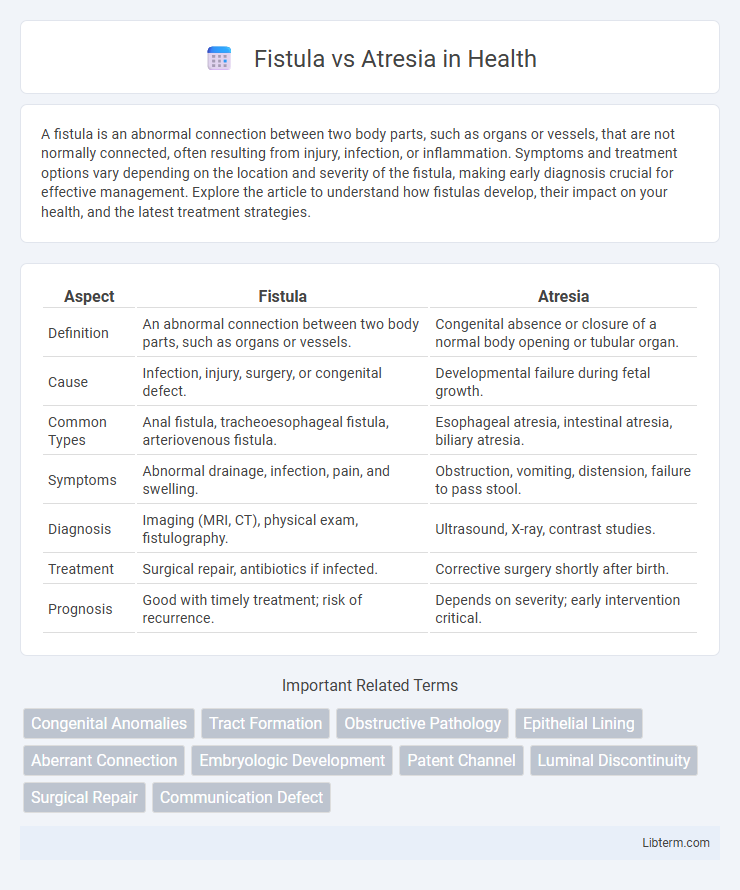A fistula is an abnormal connection between two body parts, such as organs or vessels, that are not normally connected, often resulting from injury, infection, or inflammation. Symptoms and treatment options vary depending on the location and severity of the fistula, making early diagnosis crucial for effective management. Explore the article to understand how fistulas develop, their impact on your health, and the latest treatment strategies.
Table of Comparison
| Aspect | Fistula | Atresia |
|---|---|---|
| Definition | An abnormal connection between two body parts, such as organs or vessels. | Congenital absence or closure of a normal body opening or tubular organ. |
| Cause | Infection, injury, surgery, or congenital defect. | Developmental failure during fetal growth. |
| Common Types | Anal fistula, tracheoesophageal fistula, arteriovenous fistula. | Esophageal atresia, intestinal atresia, biliary atresia. |
| Symptoms | Abnormal drainage, infection, pain, and swelling. | Obstruction, vomiting, distension, failure to pass stool. |
| Diagnosis | Imaging (MRI, CT), physical exam, fistulography. | Ultrasound, X-ray, contrast studies. |
| Treatment | Surgical repair, antibiotics if infected. | Corrective surgery shortly after birth. |
| Prognosis | Good with timely treatment; risk of recurrence. | Depends on severity; early intervention critical. |
Understanding Fistula: Definition and Types
Fistula is an abnormal connection between two organs or vessels that do not normally connect, often resulting from injury, infection, or inflammation. Common types include anal fistulas, which connect the anal canal to the skin, and tracheoesophageal fistulas, linking the trachea and esophagus, typically congenital. Understanding the specific type and location of a fistula is crucial for diagnosis and determining appropriate surgical or medical treatment options.
What is Atresia? Key Concepts and Variations
Atresia is a congenital condition characterized by the absence or closure of a normal body opening or tubular structure, resulting in obstruction or impaired function. Key variations include esophageal atresia, where the esophagus is improperly formed, and biliary atresia, involving blockage or absence of bile ducts. Understanding the specific type and location of atresia is critical for diagnosis and determining appropriate surgical or medical treatment strategies.
Causes: Fistula vs Atresia
Fistula results from abnormal connections between organs or vessels, often caused by congenital defects, infections, or trauma. Atresia, a congenital condition, occurs due to the failure of a body cavity or tubular organ to develop properly, leading to complete closure or absence. Genetic mutations and environmental factors during fetal development significantly contribute to the occurrence of both fistula and atresia.
Common Symptoms and Clinical Presentation
Fistula and atresia commonly present with symptoms such as feeding difficulties, respiratory distress, and excessive frothing at the mouth in newborns. In esophageal atresia, the esophagus ends in a blind pouch, causing choking and inability to swallow, while fistula often leads to abnormal connections between the esophagus and trachea, resulting in coughing or cyanosis during feeding. Clinical presentation frequently includes drooling, regurgitation, and recurrent pneumonia due to aspiration in both conditions.
Diagnostic Methods: Comparing Approaches
Diagnostic methods for fistula primarily involve imaging techniques such as MRI and fistulography to visualize abnormal connections between organs or vessels. Atresia diagnosis relies heavily on prenatal ultrasound and postnatal contrast studies to identify congenital absence or closure of a bodily passage. Endoscopic examination serves as a complementary approach in both conditions for direct visualization and assessment.
Treatment Options for Fistula
Treatment options for fistula primarily involve surgical intervention to close the abnormal connection between organs, such as esophageal or anal fistula repairs. Techniques may include direct fistula excision, tract ligation, or the use of advancement flaps to promote healing and prevent recurrence. Postoperative care often requires antibiotics and nutritional support to ensure optimal recovery and minimize complications.
Management Strategies for Atresia
Management strategies for atresia primarily involve surgical intervention to restore the patency of the affected lumen, with esophageal atresia requiring techniques such as primary anastomosis or staged repair depending on the gap length. Preoperative care includes stabilization with airway protection, prevention of aspiration, and nutritional support via gastrostomy or parenteral routes. Postoperative management emphasizes monitoring for complications like strictures or leakage, and long-term follow-up focuses on esophageal motility and feeding difficulties.
Prognosis and Long-Term Outcomes
Fistula prognosis varies depending on location and timely surgical intervention, with many patients achieving full recovery and minimal complications. Atresia often requires complex surgery, with long-term outcomes influenced by the severity and associated anomalies, sometimes leading to chronic digestive or respiratory issues. Early diagnosis and specialized care significantly improve survival rates and quality of life for both conditions.
Complications: Fistula vs Atresia
Fistula complications primarily include infection, abscess formation, and chronic pain due to abnormal connections between organs or vessels. Atresia complications often involve obstruction, impaired function of the affected organ, and potential for tissue damage or necrosis caused by the absence or closure of a normal body opening or lumen. Both conditions require timely diagnosis to prevent severe outcomes such as sepsis in fistula cases or life-threatening obstruction in atresia.
Prevention and Early Intervention Strategies
Prevention of fistula and atresia primarily involves advanced prenatal screening using detailed ultrasound and fetal MRI to detect anomalies early. Early intervention strategies include timely surgical correction shortly after birth to restore normal function, reducing long-term complications and improving outcomes. Coordinated care with multidisciplinary teams ensures optimal management and rehabilitation tailored to each specific condition.
Fistula Infographic

 libterm.com
libterm.com